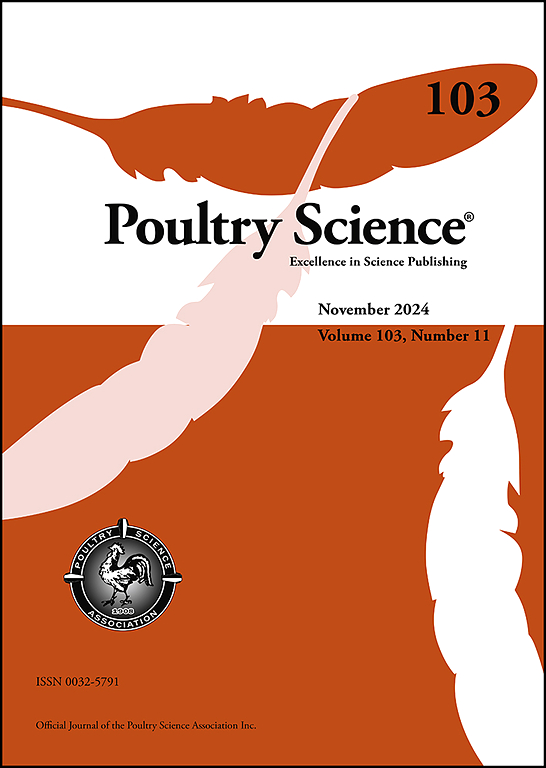Comparative study on encapsulation and sustained release of anti-Campylobacter jejuni Immunoglobulin Y Using Various pH-Responsive Beads
IF 4.2
1区 农林科学
Q1 AGRICULTURE, DAIRY & ANIMAL SCIENCE
引用次数: 0
Abstract
To protect egg yolk immunoglobulin (IgY) from degradation by pepsin and acidic conditions during oral administration, Campylobacter jejuni (C. jejuni)-specific IgY was encapsulated in polypeptide beads using various methodologies. This study compared different pH-sensitive bead formulations to optimize IgY release at the target site, enhancing C. jejuni control and improving broiler chicken performance. Among the tested formulations, methacrylic acid copolymer (Mac) and β-cyclodextrin (β-CyD) beads demonstrated high encapsulation efficiency, with Mac beads achieving the highest (94.16 %). The inclusion of β-CyD further improved encapsulation efficiency by 3.5 % compared to alginate (Alg) alone. In vitro and in vivo gastrointestinal digestion models, and enzyme-linked immunosorbent assay (ELISA), were used to assess IgY stability and release. β-CyD beads exhibited the highest stability, followed by Alg and Mac, particularly in the gastric phase. Additionally, in vivo studies confirmed that encapsulated IgY, particularly Mac beads, maintained its biological activity and effectively neutralized C. jejuni post-encapsulation. This approach presents a promising strategy for protecting IgY during digestion and ensuring its targeted release in the intestine, thereby improving intestinal health and broiler performance. Consequently, IgY encapsulation may be an efficient feed additive for mitigating C. jejuni infections in poultry.

不同ph反应微球对抗空肠弯曲杆菌免疫球蛋白Y包封与缓释的比较研究。
为了保护卵黄免疫球蛋白(IgY)在口服过程中不被胃蛋白酶和酸性条件降解,采用多种方法将空肠弯曲杆菌(C. jejuni)特异性IgY包封在多肽珠中。本研究通过比较不同ph敏感头制剂,优化IgY在靶点的释放,增强空肠梭菌的控制,提高肉鸡生产性能。其中,甲基丙烯酸共聚物(Mac)和β-环糊精(β-CyD)珠粒的包封率较高,其中Mac珠粒的包封率最高(94.16%)。与单独的海藻酸盐(Alg)相比,β-CyD的包封效率进一步提高了3.5%。采用体外和体内胃肠消化模型,以及酶联免疫吸附法(ELISA)评估IgY的稳定性和释放。β-CyD珠粒稳定性最高,其次是Alg和Mac,尤其是在胃期。此外,体内研究证实,包封后的IgY,特别是Mac微珠,保持了其生物活性,并有效地中和了空肠弧菌。该方法是一种很有前途的策略,可以在消化过程中保护卵磷脂,并确保其在肠道中有针对性地释放,从而改善肠道健康和肉鸡生产性能。因此,卵磷脂胶囊化可能是一种有效的饲料添加剂,可减轻家禽空肠梭菌感染。
本文章由计算机程序翻译,如有差异,请以英文原文为准。
求助全文
约1分钟内获得全文
求助全文
来源期刊

Poultry Science
农林科学-奶制品与动物科学
CiteScore
7.60
自引率
15.90%
发文量
0
审稿时长
94 days
期刊介绍:
First self-published in 1921, Poultry Science is an internationally renowned monthly journal, known as the authoritative source for a broad range of poultry information and high-caliber research. The journal plays a pivotal role in the dissemination of preeminent poultry-related knowledge across all disciplines. As of January 2020, Poultry Science will become an Open Access journal with no subscription charges, meaning authors who publish here can make their research immediately, permanently, and freely accessible worldwide while retaining copyright to their work. Papers submitted for publication after October 1, 2019 will be published as Open Access papers.
An international journal, Poultry Science publishes original papers, research notes, symposium papers, and reviews of basic science as applied to poultry. This authoritative source of poultry information is consistently ranked by ISI Impact Factor as one of the top 10 agriculture, dairy and animal science journals to deliver high-caliber research. Currently it is the highest-ranked (by Impact Factor and Eigenfactor) journal dedicated to publishing poultry research. Subject areas include breeding, genetics, education, production, management, environment, health, behavior, welfare, immunology, molecular biology, metabolism, nutrition, physiology, reproduction, processing, and products.
 求助内容:
求助内容: 应助结果提醒方式:
应助结果提醒方式:


